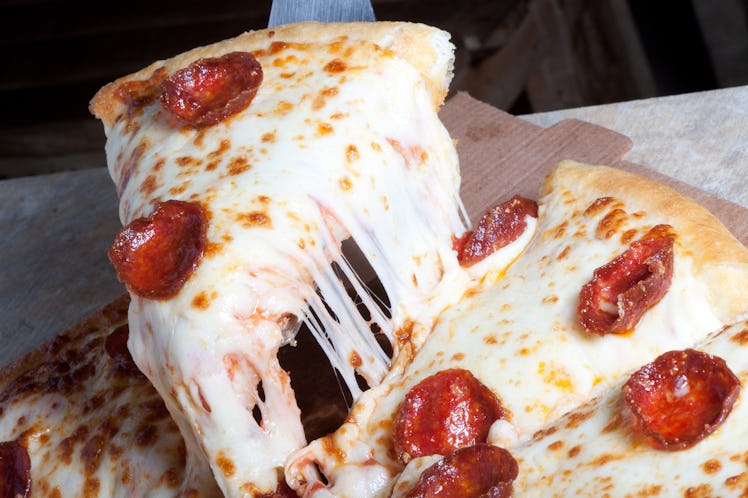I Really Miss The Pizza Hut Buffets Of The ‘90s
Few restaurants dare to combine all-you-can-eat pudding and pizza. It’s a shame, really.

All-you-can-eat Pizza Hut buffets were by far the best thing to happen to pizzas, buffets, and anyone who didn’t care about their bodies in the 1990s. Where I’m from, the proud and intermittently trashy state of Illinois, they were a pre-Seamless staple and an excuse to visit the red-roofed sanctuary that was America’s foremost pseudo-Italian food franchise. At that time, Pizza Hut was a freewheeling, come-as-you-are-at-your-worst sort of place best understood in terms of the proximity of the pizza to the pudding. For the low price of $3.99 — $1.99 for anyone under the age of 10 — a nutrient-agnostic diner could have it all.
The first ever Pizza Hut was open by brothers Dan and Frank Carney in Wichita, Kansas in 1958. The name reportedly came from Dan’s wife who thought the first lazily construction location looked like a hut. As the company expanded, the recognizable red, shingled roofs proliferated across the country. The buffets made their debut early in the summer of 1992. The year before the business had grown by 10 percent, but due to increased delivery sales. So, naturally, Pizza Hut doubled down on dining in. Some 2,000 14-foot, all-you-can-eat buffets were installed across America.
Did the experiment in buffet technology work? It depends on what metric you privilege. Did it make Pizza Hut more successful? No. Did it help the executive pull in more customers? Hard to say. “You cannot have one asset that is flat or growing very slowly and have the entire company growing very rapidly,” senior vice president of marketing for PepsiCo Bob Perkins, told the New York Times in 1992. The idea was that buffets would supercharge dine-in growth alongside delivery growth.
By 1999, it was pretty clear that wasn’t going to happen. But Pizza Hut dug in its stuffed, crusty heels. The suits wanted to make it work. They wanted to advertise having the best pizza and then they wanted to serve it at the continental breakfast from hell. God bless them.
The problem was that unlimited pizza, pasta, and salad were no match for simultaneous trend away from buffets. Pizza Hut was headed toward consolidation. Today, many of the trademark red roofs are pitched atop non-pizza businesses. There are Verizon stores and Sbarros in old Pizza Huts. People sell wrenches where proud buffets once steamed, as if they didn’t have a crucial impact on so many childhoods for the better part of a decade. It’s like the Tooth Fairy just up and quit to become a stripper.
Without the buffets on the inside, kids today are missing out on a lot more than a pointless amount of mediocre pizza. Those buffets functioned as open bars for tiny people who couldn’t yet enjoy open bars. It was Fuddruckers for those unprepared for Fuddruckers. Eating from the buffet wasn’t a nutritional experience, it was a formative one. Pizza Hut buffets prepared me for a decade of sloppy wedding receptions.
Pizza Hut was also a place where kids learned that messiness — banished from home — was, in fact, a genuine option. At home, wasting food, leaving the table intermittently, and mixing foods in bizarre ways was discouraged. At Pizza Hut it was normal. The buffet was a free-for-all by design — not unlike America. It is where I learned that butter knives don’t break skin and that I can, in fact, eat whatever I want if I’m willing to pay the consequences.
Those may not be good lessons, but they were valuable.
And, despite all that bread and cheese, my parents always seemed lighter at Pizza Hut. Maybe it was because they didn’t have to cook, cleanup, or break the bank. Maybe it was because they found the sound of a plate being dropped every three to four minutes as calming as I did. As remarkably unremarkable as it all was, we were all happy to be there. The Pizza Hut buffet was stupid in a specific sort of way that we could experience and share together. It was, well, nice.
Though 1990s Pizza Hut seemed made for children (Land Before Time puppets, pudding, monosyllabic menus), it was actually designed for exhausted mothers and fathers. How do I know this? Two reasons. First of all, there is a provision in several states’ liquor laws called the “Pizza Hut Exception,” which permits parents to drink beer while their kids roam free range. Secondly, I saw my parents in that environment. They loved it.
The genius of the Pizza Hut buffet was that it was a bait-and-switch. The kids thought it was for them, but it wasn’t. It was for adults who just didn’t want to cope. At Pizza Hut, you didn’t have to. Nobody expected you to put on a face. Nobody tried. I liked that.
This article was originally published on